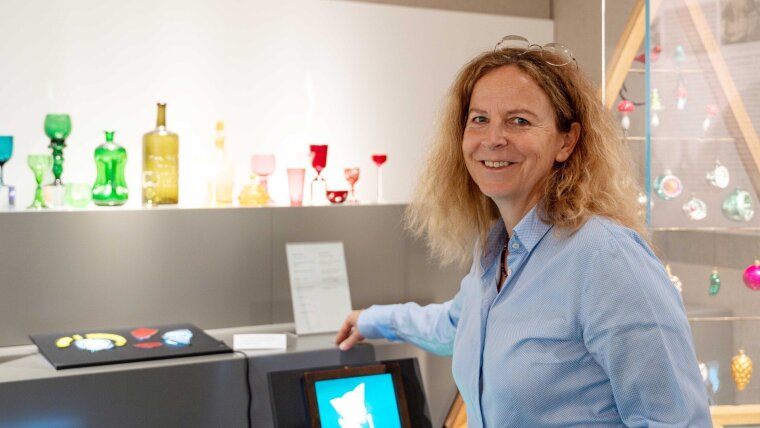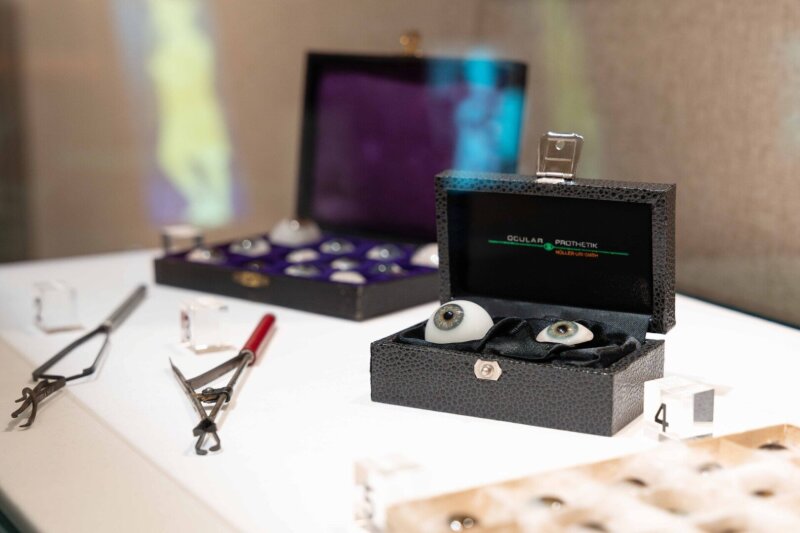
Published: | By: Axel Burchardt
Source article
A highlight of the exhibition are these glass eye prostheses made in Lauscha, Thuringia, in the 19th century, and the 'instruments' used to make glass eyes.
Image: Nicole Nerger/Universität JenaAt first glance, the translucent vials of antiquity and the brightly coloured stained glass by Jena artist Fritz Körner, the sparkling crystal goblet from around 1700 and the simple teapot by Wilhelm Wagenfeld seem worlds apart. However, all of these artefacts were made of glass, a material that is obtained from the fusion of the simplest materials such as quartz sand and wood ash and whose aesthetic versatility and adaptability to a wide variety of purposes seem almost infinite. The special effect of glass objects results from the unique symbiosis of transparency and light. This also lends utilitarian vessels an immaterial appearance. The new exhibition "Glamour, light, art, symbol, solution. A brief cultural history of glass" at Friedrich Schiller University Jena. It will open on 27 September 2024 at 7 p.m. in the exhibition cabinet (room 0.25) in the University Main Building (Fürstengraben 1). It will then be on display until 8 November from Monday to Friday from 11 am to 4 pm.
Glass from antiquity to modern times
In a total of six sections, the exhibition offers an art and cultural-historical journey through the History of the Ancient World to the Modern Age. The functional-technical potential and the manufacturing traditions of glass, some of which go back a long way, are thematised, as are the changing demands on the material in terms of usability and aesthetics. A special focus of the show is on the development of the glass industry in Jena, whose founder Otto Schott worked closely with Carl Zeiss, the father of the precision optics industry, from the very beginning - a pioneering collaboration that has shaped the history of the city and its university to this day. Important Bauhaus artists in Weimar such as Wilhelm Wagenfeld and László Moholy-Nagy gave Schott's products their iconic shape. "One of the birthplaces of modern industrial design is therefore in Jena," says Prof. Dr Juliane von Fircks from the University of Jena. The art historian realised the presentation together with her colleague Prof. Dr Maria Deiters from TU Berlin and students. The wide range of objects in the exhibition was made possible by loans from the collections of Jena University, the Schott Archive, the Museum Baruther Glashütte with the collection of Uta Stockmann, the German Optical Museum (D.O.M.) and a number of other private loans.
Exhibition as part of a major conference
The exhibition will be shown as part of the VII Forum Art of the Middle Ages, which will take place in Jena from 25 to 28 September 2024. Organised by the Institute of Art and Cultural Studies at Friedrich Schiller University (Juliane von Fircks, Svea Janzen) together with the German Association for Art History and Film Studies, the theme of the conference is "Light: Art, Metaphysics and Science in the Middle Ages".
Fürstengraben 18
07743 Jena Google Maps site planExternal link
